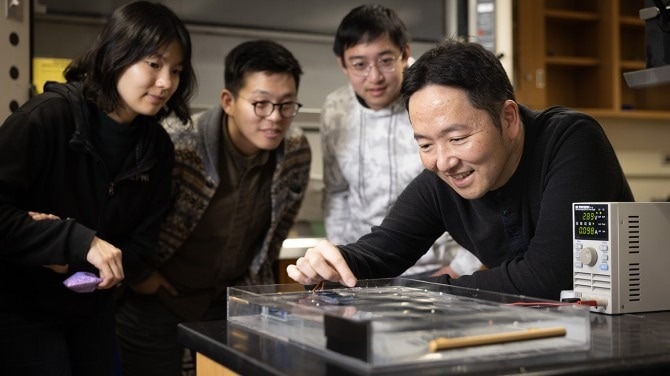Motivated by a small snail's deliberate and measured pace, scientists have created a prototype robot with the potential to collect microplastics from the surfaces of oceans, seas, and lakes in the future.
 Sunny Jung, professor of biological and environmental engineering (far right), and study coauthors (from left), Jisoo Yuk, Chris Roh and Yicong Fu, watch a demonstration of their snail-inspired robot. Image Credit: Jason Koski/Cornell University.
Sunny Jung, professor of biological and environmental engineering (far right), and study coauthors (from left), Jisoo Yuk, Chris Roh and Yicong Fu, watch a demonstration of their snail-inspired robot. Image Credit: Jason Koski/Cornell University.
The robot's design takes inspiration from the Hawaiian apple snail (Pomacea canaliculate), a commonly found aquarium snail known for utilizing the rhythmic motion of its foot to generate water surface flow and draw in suspended food particles.
Presently, mechanisms for plastic collection predominantly rely on drag nets or conveyor belts to amass and eliminate larger plastic debris from water bodies. However, these methods lack the precision needed for the retrieval of microplastics, which are minuscule plastic particles.
These tiny plastic particles have the potential to be consumed by marine animals, leading to their incorporation into the tissues and subsequently entering the food chain. This poses a significant health risk and has the potential to be carcinogenic to humans.
According to the United Nations Economic and Social Council, plastic waste constitutes a staggering 80% of all marine pollution, contributing to an annual influx of 8 to 10 million metric tons of plastic into the oceans. The development of this snail-inspired robot offers a promising approach to addressing the critical issue of microplastic contamination in aquatic environments.
We were inspired by how this snail collects food particles at the [water and air] interface to engineer a device that could possibly collect microplastics in the ocean or at a water body’s surface.
Sunghwan “Sunny” Jung, Professor and Director, Graduate Studies, Department of Biological and Environmental Engineering, College of Agriculture and Life Sciences (CALS), Cornell University
Jung is the Senior Author of the study, which was published online in the journal Nature Communications on November 25th, 2023.
To make the prototype viable for real-world applications, the researchers adapted an existing design, recognizing the necessity for scaling up.
Employing a 3D printer, they crafted a pliable sheet resembling a carpet, endowed with the ability to undulate. Beneath the sheet, a helical structure operates like a corkscrew, inducing undulations in the carpet and generating a progressive wave on the water's surface.
A crucial aspect of this research involved a meticulous analysis of fluid motion to comprehend and optimize the undulating dynamics of the flexible sheet.
We needed to understand the fluid flow to characterize the pumping behavior.
Sunghwan “Sunny” Jung, Professor and Director, Graduate Studies, Department of Biological and Environmental Engineering, College of Agriculture and Life Sciences (CALS), Cornell University
The fluid-pumping system, inspired by the snail's methodology, operates openly in the air. The researchers determined that adopting a closed system, where the pump is enclosed and utilizes a tube for water and particle intake, would demand substantial energy inputs for operation.
In contrast, the snail-inspired open system proves significantly more efficient. For instance, the prototype, despite its small size, functions effectively on a mere 5 volts of electricity, as highlighted by Jung. To counterbalance the weight of the battery and motor, the researchers may need to affix a flotation device to the robot to prevent it from sinking, as suggested by Jung.
The primary author of the paper is Anupam Pandey, a Former Postdoctoral Researcher in Jung’s lab, currently serving as an Assistant Professor of Mechanical Engineering at Syracuse University.
Additional contributors to the research include Chris Roh, Assistant Professor of biological and environmental engineering (CALS); Jisoo Yuk, Ph.D. '20, a Former Graduate Student in Jung's lab; Daisuke Takagi, Associate Professor of mathematics at the University of Hawaii; and Sungyon Lee, Associate Professor of mechanical engineering at the University of Minnesota.
The study was financially supported by the National Science Foundation.
Snail-inspired robot could scoop ocean microplastics
Snail-inspired robot could scoop ocean microplastics. Video Credit: Cornell University.
Journal Reference:
Pandey, A., et al. (2023) Optimal free-surface pumping by an undulating carpet. Nature Communications. doi.org/10.1038/s41467-023-43059-8.